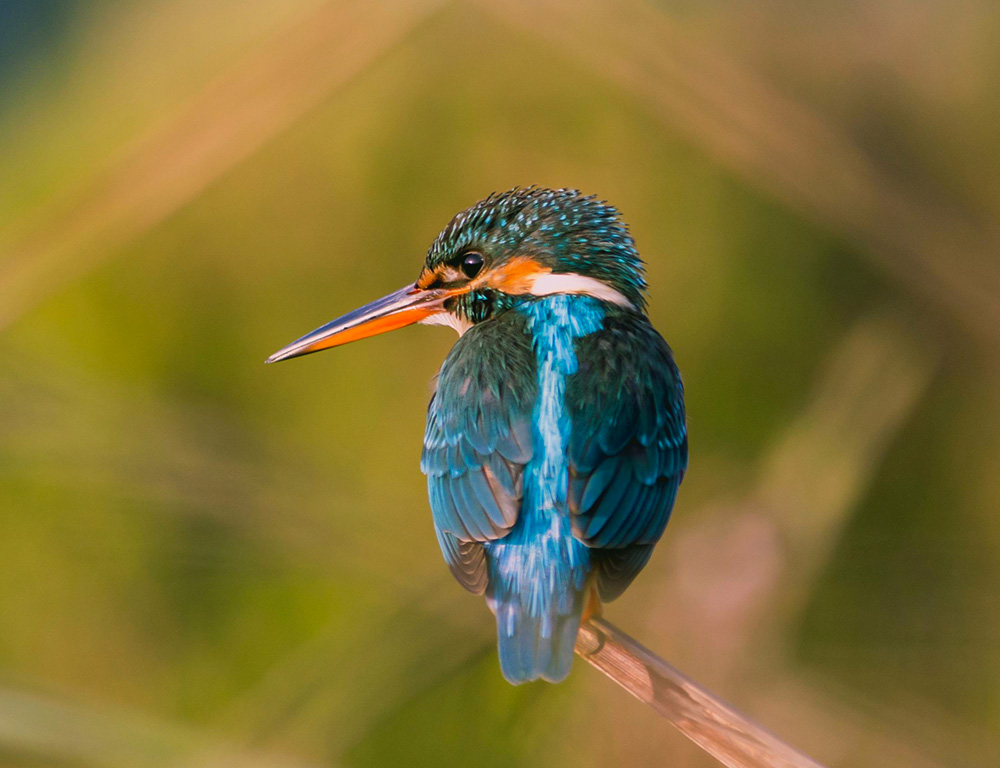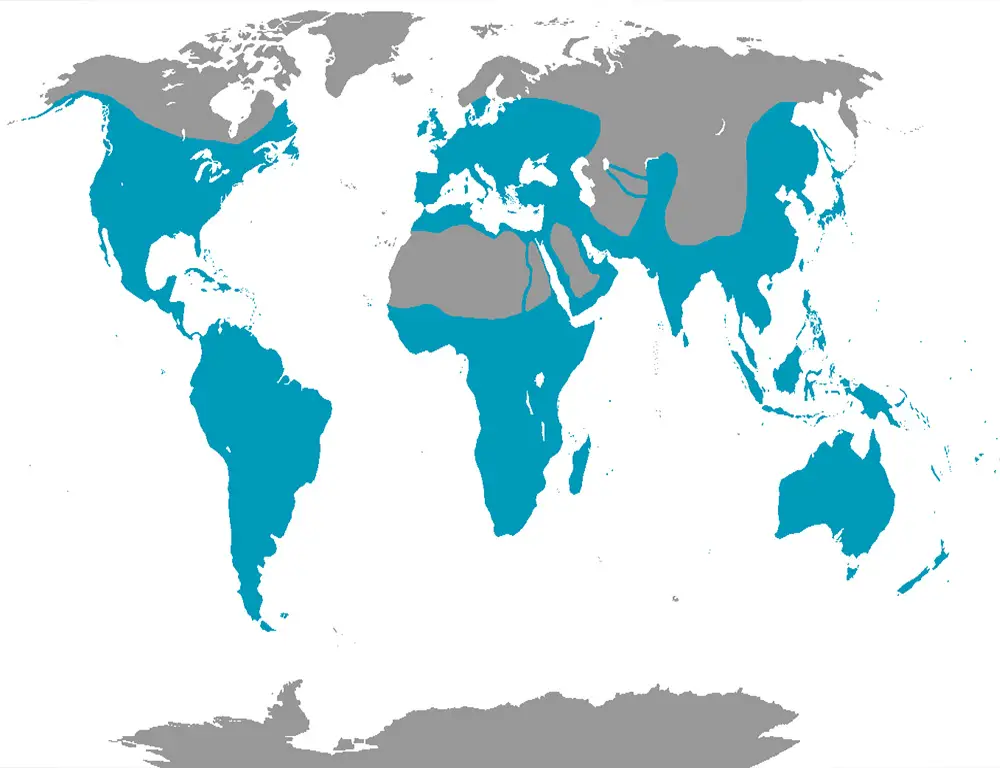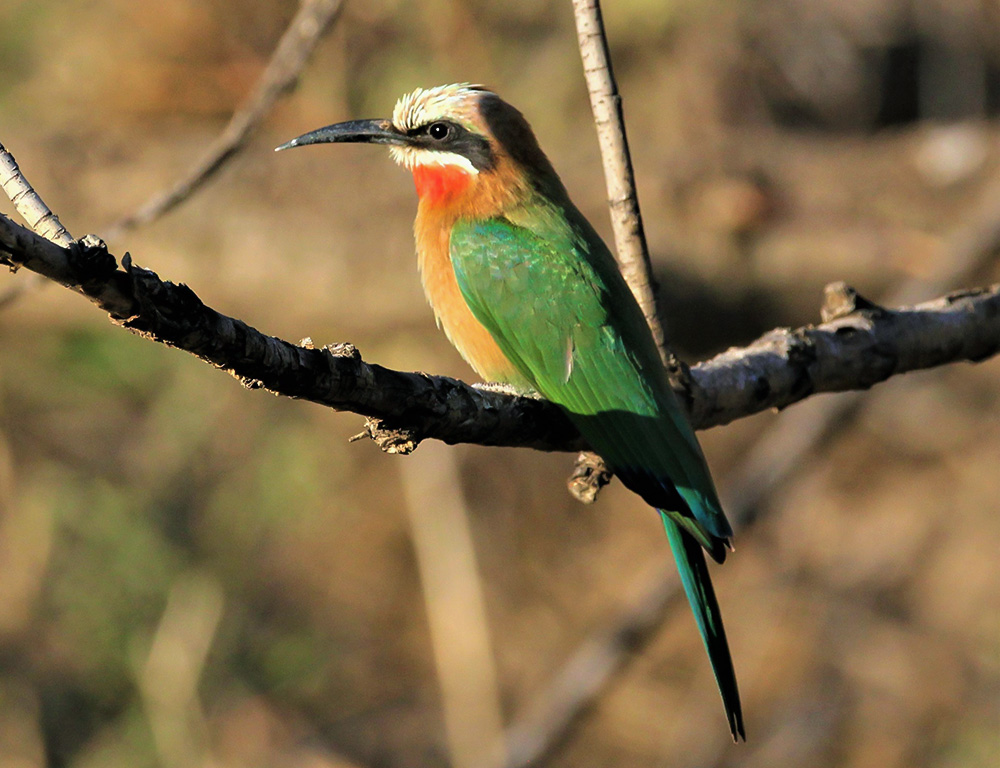The avian order of Coraciiformes includes a diverse array of birds, each boasting distinctive traits and habitats.
From the graceful elegance of kingfishers to the vivid charm of bee-eaters, Coraciiformes encompass a spectrum of species that captivate bird enthusiasts and scientists alike.
Coraciiformes are a special group in the natural world, defined by their striking plumage, vibrant colors, and often peculiar behaviors.
Their name derives from the Latin word “coracias,” meaning raven or crow, highlighting the historical fascination with these captivating creatures.
In this exploration, we embark on a journey to uncover the wonders of Coraciiformes, delving into their evolutionary history, ecological roles, and remarkable adaptations.
From the tropical forests of South America to the savannas of Africa and beyond, Coraciiformes showcase the marvels of avian diversity and the intricate interconnectedness of life on our planet. Join us as we unravel the secrets of these enchanting birds.

Characteristics of the Coraciiformes
The Coraciiformes order encompasses diverse birds known for their striking colors, unique adaptations, and fascinating behaviors.
Understanding the key characteristics that define this avian order provides valuable insights into their ecology, evolutionary history, and conservation.
Let’s delve into the identifying features of Coraciiformes and explore the habits that make them distinct in the avian world.
Physical Characteristics
One of the most striking features of Coraciiformes is their vibrant plumage. Many species within this order exhibit bold blue, green, orange, and red hues, making them visually captivating.
Their plumage often serves as camouflage in their respective habitats, helping them blend into the surrounding foliage or water bodies while hunting for prey.
Coraciiformes are typically medium-sized birds with compact bodies, substantial bills, and relatively short legs. Their bills are well-adapted for catching and consuming various prey items, ranging from fish to insects.
Additionally, many species have sharp, pointed bills ideal for piercing through the exoskeletons of their prey.
One notable physical characteristic of Coraciiformes is their zygodactyl feet, which means they have two toes pointing forward and two toes pointing backward.
This foot structure gives them excellent grip and stability, especially when perching on branches or hunting for prey.
Habitat Preferences
Coraciiformes exhibit various habitat preferences, from lush tropical forests to open savannas and riverine environments. Their adaptability allows them to thrive in multiple ecosystems worldwide, including terrestrial and aquatic habitats.
Kingfishers, a well-known family within the Coraciiformes order, are often associated with freshwater habitats such as rivers, streams, and lakes.
These birds rely on transparent water bodies to hunt for fish, insects, and crustaceans, using their keen eyesight to spot prey from perches along the water’s edge.
Bee-eaters, another group of Coraciiformes, prefer more open habitats such as grasslands, savannas, and agricultural areas.
These birds feed primarily on flying insects, including bees, wasps, and dragonflies, and are often seen perched on branches or wires, scanning the sky for their next meal.
Rollers, with their distinctive aerial acrobatics, inhabit various landscapes, including woodlands, scrublands, and even urban areas.
They are known for their spectacular courtship displays and are often observed performing looping flights and elaborate dives to attract mates.
Overall, the habitat preferences of Coraciiformes are closely tied to their specific dietary requirements and hunting strategies.
While some species specialize in fishing in freshwater habitats, others rely on catching insects in open grasslands or forests.
Foraging and Feeding Behavior
Coraciiformes exhibit a range of foraging and feeding behaviors tailored to their specific dietary preferences and hunting techniques. Kingfishers, for example, are adept at diving from perches into the water to catch fish with their sharp bills.
Their zygodactyl feet enable them to maintain stability while hovering above the water before plunging in to capture prey.
Bee-eaters employ a different strategy, relying on aerial pursuits to catch flying insects on the wing. With their agile flight and sharp vision, they can catch insects mid-air and return to a perch to consume their meal.
Rollers often hunt from elevated perches, scanning the surrounding area for potential prey. Once a suitable target is identified, they swoop down to capture it with a swift motion of their bill.
Their hunting techniques may vary depending on prey availability and environmental conditions.
Social Structure and Communication
Coraciiformes exhibit diverse social structures and communication methods, ranging from solitary to highly social species.
While some species are primarily solitary and maintain territories for breeding and foraging, others form loose flocks or colonies, particularly during the breeding season.
Communication among Coraciiformes involves a variety of vocalizations, displays, and body language. These signals are used for mate attraction, territorial defense, and coordination during group activities such as hunting or roosting.
Taxonomy of Coraciiformes
| Taxonomy Level | Classification |
| Kingdom | Animalia |
| Phylum | Chordata |
| Class | Aves |
| Order | Coraciiformes |
| Family | Alcedinidae, Meropidae, Momotidae, Todidae, and others |
Range Map

Coraciiformes are found on all continents except Antarctica, with the highest species diversity occurring in tropical and subtropical regions. They inhabit many habitats, including forests, grasslands, wetlands, and coastal areas.
Food Habits
Coraciiformes have diverse dietary preferences depending on their species and habitat. Everyday food items include fish, insects, crustaceans, small mammals, reptiles, and amphibians.
Kingfishers primarily feed on fish, while bee-eaters specialize in catching flying insects. Rollers and motmots may consume various prey items, including insects, small birds, and fruits.
Nesting
| Species | Nest Type | Nest Location | Clutch Size |
| Kingfishers | Burrow | Riverbanks | 3-7 eggs |
| Bee-eaters | Burrow or Tunnel | Earthen banks | 4-7 eggs |
| Rollers | Cavity | Tree hollows | 2-4 eggs |
| Motmots | Cavity or Tunnel | Slopes or cliffs | 2-4 eggs |
Breeding
Coraciiformes exhibit various breeding habits, with breeding seasons often coinciding with favorable environmental conditions and food availability.
Many species form monogamous pairs and engage in elaborate courtship displays to attract mates. Nest construction, incubation, and chick rearing are typically shared responsibilities between parents.
Conservation Status
While some species of Coraciiformes are abundant and widespread, others face threats such as habitat loss, pollution, and climate change. Conservation efforts are crucial to protect vulnerable species and their habitats.
Several species, including the Guam kingfisher and the blue-banded kingfisher, are listed as endangered or critically endangered due to habitat destruction and predation by introduced species.
Continued monitoring and conservation actions are essential to ensure the long-term survival of Coraciiformes populations worldwide.
Migration Patterns
Some species of Coraciiformes are migratory, undertaking seasonal movements to access food resources or breed in more favorable climates.
Migration routes vary among species. Some undertake long-distance journeys across continents, while others migrate shorter distances within their range.
Predator-Prey Interactions
Coraciiformes play essential roles in their ecosystems as both predators and prey. They are preyed upon by various predators, including raptors, snakes, and mammals.
Additionally, they contribute to regulating insect populations and maintaining the balance of aquatic ecosystems through their feeding habits.
Adaptations to Climate Change
Coraciiformes may face challenges due to climate change, including shifts in habitat availability, altered food availability, and increased frequency of extreme weather events.
Some species may exhibit behavioral adaptations, such as changes in migration timing or shifts in breeding habitats, to cope with changing environmental conditions.
Conservation efforts to preserve diverse habitats and minimize human-induced impacts can help mitigate the effects of climate change on Coraciiformes populations.
Common Diseases and Treatments of the Coraciiformes
Coraciiformes, like all birds, are susceptible to various diseases and health issues that can affect their well-being.
Veterinarians and wildlife professionals can help safeguard the health of these captivating birds by identifying common diseases and implementing appropriate treatments.
Avian Pox
Avian pox is a viral disease that affects many bird species, including Coraciiformes. It presents as wart-like growths on the skin, mucous membranes, or internal organs, leading to respiratory distress, impaired vision, and decreased immune function.
Treatment typically involves supportive care to alleviate symptoms and prevent secondary infections. Vaccination may also be utilized in captive populations to prevent the spread of the virus.
Aspergillosis
Aspergillosis is a fungal infection caused by the Aspergillus fungus, which can affect the respiratory system of Coraciiformes. Birds may exhibit symptoms such as difficulty breathing, lethargy, and nasal discharge.
Treatment involves antifungal medications administered orally, topically, or via nebulization. Environmental management, including maintaining clean and dry enclosures, is crucial for preventing the spread of Aspergillus spores.
Lead Poisoning
Lead poisoning is a significant concern for Coraciiformes, particularly those that consume prey contaminated with lead ammunition or fishing tackle. Birds may display neurological symptoms such as weakness, tremors, and seizures.
Treatment involves chelation therapy to remove lead from the bloodstream and supportive care to manage symptoms. Preventative measures, such as using non-toxic ammunition and tackle, are essential for mitigating lead exposure in wild populations.
Parasitic Infections
Coraciiformes are susceptible to various parasitic infections, including internal parasites such as worms and external parasites such as mites and lice. These parasites can cause gastrointestinal issues, feather damage, and skin irritation.
Treatment may involve antiparasitic medications administered orally, topically, or via injection. Preventative measures, such as regular parasite screenings and maintaining clean living environments, are essential for controlling parasite infestations.
Nutritional Deficiencies
Improper diet and inadequate nutrition can lead to nutritional deficiencies in Coraciiformes, affecting their overall health and reproductive success. Common deficiencies include vitamin A, calcium, and protein.
Treatment involves correcting the diet to provide essential nutrients through supplementation or dietary modifications.
Regular monitoring of nutritional status and consultation with avian nutrition specialists are essential for preventing and addressing dietary deficiencies in captive populations.
Infectious Diseases
Coraciiformes are susceptible to infectious diseases, including bacterial, viral, and protozoal infections. Common pathogens include Salmonella, Avian influenza virus, and Trichomonas.
Treatment involves antimicrobial medications targeted at specific pathogens and supportive care to manage symptoms and prevent transmission.
Preventative measures, such as strict biosecurity protocols and routine health screenings, are essential for reducing the risk of infectious disease outbreaks in captive and wild populations.
Discover 6 Fascinating Facts About the Coraciiformes

The Coraciiformes order comprises a diverse group of birds, from the iconic kingfishers to the colorful bee-eaters. Delve into the intriguing world of Coraciiformes with these six captivating facts.
1. Incredible Diversity
Coraciiformes exhibit remarkable diversity, with over 200 species found worldwide. From tropical rainforests to arid savannas, these birds inhabit various habitats, showcasing their adaptability and ecological versatility.
2. Vivid Plumage
Many Coraciiformes species boast vibrant plumage adorned with blue, green, orange, and red hues. Their striking colors serve as visual signals for courtship and territorial displays and provide camouflage in their respective environments.
3. Unique Hunting Techniques
Coraciiformes employ various hunting techniques tailored to their specific dietary preferences and habitats. Kingfishers are skilled fish hunters, diving from perches to catch their prey underwater, while bee-eaters capture flying insects with swift aerial pursuits.
4. Cooperative Breeding
Several species of Coraciiformes engage in cooperative breeding, where individuals from the same family group assist in raising the young.
This cooperative behavior helps improve the offspring’s chances of survival and reinforces social bonds within the group.
5. Burrowing Nesters
Many Coraciiformes species, such as kingfishers and bee-eaters, are burrow-nesters. They excavate tunnels in earthen banks or cliffs to build nesting sites.
These burrows protect them from predators and harsh weather conditions, ensuring the safety of their eggs and chicks.
6. Ecological Importance
Coraciiformes are vital in ecosystem dynamics as predators, prey, and seed dispersers. By controlling insect populations, pollinating flowers, and contributing to nutrient cycling, these birds help maintain the balance of their respective habitats.
FAQs
What is the Coraciiformes order?
Coraciiformes is an order of birds that includes species such as kingfishers, bee-eaters, rollers, and motmots. These birds are known for their vibrant plumage and unique hunting behaviors.
Where are Coraciiformes found?
Coraciiformes are found on all continents except Antarctica, with the highest species diversity occurring in tropical and subtropical regions. They inhabit various habitats, including forests, wetlands, grasslands, and coastal areas.
What do Coraciiformes eat?
The diet of Coraciiformes varies depending on the species and habitat. Everyday food items include fish, insects, crustaceans, small mammals, reptiles, and amphibians.
Kingfishers primarily feed on fish, while bee-eaters specialize in catching flying insects.
How do Coraciiformes hunt for prey?
Coraciiformes employ various hunting techniques tailored to their specific dietary preferences and habitats. Kingfishers can dive from perches to catch fish underwater, while bee-eaters capture flying insects with swift aerial pursuits.
Which Coraciiformes are endangered?
While some species of Coraciiformes are abundant and widespread, others face threats such as habitat loss, pollution, and climate change. Several species, including the Guam and blue-banded kingfisher, are listed as endangered or critically endangered.
Conclusion
The Coraciiformes stand as a testament to avian life’s incredible diversity and adaptability. Through their vibrant colors, unique behaviors, and specialized ecological niches, these birds have captured the imagination of scientists and nature enthusiasts worldwide.
From the agile kingfishers diving into rivers to catch their prey to the elegant rollers soaring across open landscapes, each species within this order offers a glimpse into the fascinating intricacies of evolutionary adaptation.
As stewards of our planet, we must recognize the importance of preserving the habitats and ecosystems that support Coraciiformes and countless other species.
By understanding and protecting these birds and their environments, we safeguard the biodiversity of our world and ensure a sustainable future for generations to come.
Let us continue to marvel at the wonders of Coraciiformes and strive to conserve the natural heritage they represent.